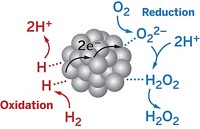Advertisement
Grab your lab coat. Let's get started
Welcome!
Welcome!
Create an account below to get 6 C&EN articles per month, receive newsletters and more - all free.
It seems this is your first time logging in online. Please enter the following information to continue.
As an ACS member you automatically get access to this site. All we need is few more details to create your reading experience.
Not you? Sign in with a different account.
Not you? Sign in with a different account.
ERROR 1
ERROR 1
ERROR 2
ERROR 2
ERROR 2
ERROR 2
ERROR 2
Password and Confirm password must match.
If you have an ACS member number, please enter it here so we can link this account to your membership. (optional)
ERROR 2
ACS values your privacy. By submitting your information, you are gaining access to C&EN and subscribing to our weekly newsletter. We use the information you provide to make your reading experience better, and we will never sell your data to third party members.
Synthesis
Copper Adds Splitting Water To Résumé
Chemists develop the first copper-based homogeneous catalyst for electrolytic water oxidation
by Stephen K. Ritter
May 7, 2012
| A version of this story appeared in
Volume 90, Issue 19
For the first time, chemists have prepared a homogeneous copper-based water-oxidation catalyst, opening a new direction in electrofuels research (Nat. Chem., DOI: 10.1038/nchem.1350). Sunlight-driven electrolytic water oxidation to make O2 is a hot topic in catalysis because it is the more difficult half of the two-pronged reaction needed to split water to make H2 for powering fuel cells. The best electrocatalysts to date are made from iridium and ruthenium. But chemists are interested in using less costly, Earth-abundant metals to meet anticipated future catalyst demand. For example, cobalt and iron are already being studied. Shoshanna M. Barnett, Karen I. Goldberg, and James M. Mayer of the University of Washington, Seattle, mixed copper salts and bipyridine at high pH, leading to in situ formation of the bipyridine hydroxo complex shown. Most soluble electrocatalysts require multistep preparation, they note. The researchers found that the catalyst promotes O2 production at a rate of about 100 cycles per second, which is among the most rapid rates observed for soluble water-oxidation catalysts. The complex requires a moderate overpotential of 750 mV—the additional energy needed to push the reaction to completion—which Mayer says his team is trying to reduce.




Join the conversation
Contact the reporter
Submit a Letter to the Editor for publication
Engage with us on Twitter